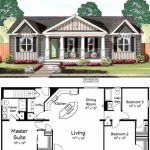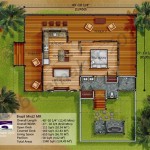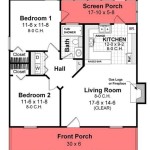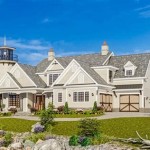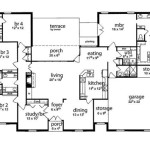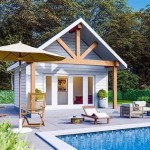Design Ideas for House Plans with In-Law Suites and Kitchens in the Philippines
The multi-generational home is becoming increasingly prevalent in the Philippines, driven by cultural traditions, economic factors, and a desire for closer family ties. This trend necessitates house plans that effectively integrate independent living spaces, specifically those incorporating in-law suites equipped with their own kitchen facilities. Careful planning and design are crucial to ensure both privacy and connection within the shared residence. This article explores various design considerations and ideas for creating functional and comfortable house plans with in-law suites and kitchens, tailored to the specific context of the Philippines.
In the Philippine context, family support and shared resources are deeply ingrained in the culture. Having an in-law suite within the home allows elderly parents or other family members to maintain their independence while remaining close to loved ones for assistance and companionship. Furthermore, providing a separate kitchen within the in-law suite addresses dietary needs and preferences, promoting autonomy and minimizing potential friction points. The design must therefore balance individual needs with the overall harmony of the household.
Strategic Placement and Layout Considerations
One of the primary considerations in designing a house plan with an in-law suite is the strategic placement of the suite within the overall structure. Several options exist, each with its own advantages and disadvantages. A common approach is to locate the suite on the ground floor, providing easy access for elderly or mobility-impaired relatives. This eliminates the need for stairs, minimizing the risk of falls. Alternatively, the suite could be situated as an addition to the main house, connected by a hallway or breezeway. This arrangement allows for a clear separation of spaces, maximizing privacy for both the main household and the in-law suite.
Another option is to incorporate the in-law suite into the second story of the house, potentially above a garage or other common area. This approach can be beneficial in maximizing lot usage, particularly on smaller properties common in urban areas of the Philippines. However, accessibility becomes a crucial factor, requiring careful consideration of staircase design or the installation of an elevator or chairlift. Regardless of the location, it is important to ensure that the in-law suite has its own separate entrance, providing a sense of independence and control over their living space.
Within the in-law suite itself, the layout should be thoughtfully designed to optimize functionality and comfort. The kitchen should be compact yet efficient, equipped with essential appliances such as a refrigerator, stovetop, microwave, and sink. Adequate counter space and storage are also crucial for food preparation and organization. A small dining area or breakfast nook can provide a designated space for meals. The living area should be comfortable and inviting, offering a place for relaxation and entertainment. The bedroom should be spacious enough to accommodate a bed, dresser, and other personal belongings. Finally, the bathroom should be accessible and equipped with safety features such as grab bars and a non-slip floor.
Privacy considerations extend beyond the physical separation of spaces. Soundproofing measures, such as insulated walls and double-paned windows, can help to minimize noise transfer between the main house and the in-law suite. Orienting the windows of the in-law suite away from the main house can also enhance privacy. Furthermore, landscaping can be used to create a visual barrier between the two living spaces.
Kitchen Design and Appliance Selection
The kitchen is a central element of any in-law suite, providing the occupants with the ability to prepare their own meals and maintain their independence. When designing the kitchen, it is important to consider the specific needs and preferences of the individuals who will be using it. For elderly residents, accessibility and ease of use are paramount. Countertops should be at a comfortable height, and appliances should be easy to operate. Ample lighting is essential for visibility and safety. Non-slip flooring can help to prevent falls.
Appliance selection should be carefully considered, taking into account both functionality and energy efficiency. A compact refrigerator is sufficient for storing perishable food items. A small stovetop or induction cooktop is ideal for preparing simple meals. A microwave oven provides a convenient way to heat up leftovers or cook single-serving dishes. A sink with a pull-out faucet makes it easier to wash dishes and fill pots. Energy-efficient appliances can help to reduce utility bills and minimize environmental impact.
Storage is another important consideration in kitchen design. Cabinets should be designed to maximize space and accessibility. Pull-out shelves and drawers can make it easier to reach items stored at the back of cabinets. A pantry or storage closet can provide additional space for storing non-perishable food items and kitchen supplies. The choice of materials for countertops, cabinets, and flooring should be durable, easy to clean, and aesthetically pleasing. Common choices in the Philippines include granite, marble, and tile.
Ventilation is crucial for removing cooking odors and preventing the buildup of moisture. A range hood above the stovetop is essential for venting fumes and smoke. Windows can also provide natural ventilation. Adequate lighting is important for food preparation and safety. Under-cabinet lighting can provide task lighting for countertops.
The overall style of the kitchen should complement the rest of the in-law suite and the main house. A cohesive design aesthetic can create a more harmonious living environment. Consider incorporating Filipino design elements, such as capiz shell accents or woven rattan furniture, to create a sense of place.
Accessibility and Aging-in-Place Features
In many cases, in-law suites are designed to accommodate elderly parents or relatives who may have mobility limitations. Therefore, accessibility and aging-in-place features are essential considerations. As mentioned previously, locating the suite on the ground floor is often the most practical solution for minimizing the need for stairs. If stairs are unavoidable, they should be designed with wider treads, shorter risers, and sturdy handrails on both sides.
Within the in-law suite, doorways should be wide enough to accommodate wheelchairs or walkers. Hallways should be clear and uncluttered, with ample space for maneuverability. Bathrooms should be designed with accessible features such as grab bars near the toilet and shower, a walk-in shower or roll-in shower with a seat, and a raised toilet seat. Sinks should be at a comfortable height and have knee space underneath for wheelchair users.
Lighting is crucial for visibility and safety. Bright, even lighting throughout the in-law suite can help to prevent falls. Motion-sensor lights can be installed in hallways and bathrooms to provide automatic illumination. Non-slip flooring is essential for preventing slips and falls. Consider installing textured tiles or non-slip mats in bathrooms and kitchens.
Assistive technology can also be incorporated into the in-law suite to enhance safety and independence. Voice-activated lighting and appliances can make it easier for elderly residents to control their environment. Emergency call systems can provide a way to summon help in case of a fall or other emergency. Smart home technology can be used to monitor vital signs and track medication adherence.
The design of the in-law suite should be flexible and adaptable to accommodate changing needs over time. Adjustable-height countertops and tables can be adjusted to different heights to accommodate wheelchair users or individuals with limited mobility. Universal design principles should be applied throughout the in-law suite to create a space that is accessible and usable by people of all ages and abilities.
Landscaping around the in-law suite should also be considered for accessibility. Ramps or gentle slopes should be used to provide access to the entrance. Pathways should be wide and smooth, with no tripping hazards. Outdoor lighting can enhance safety and security at night.
Designing an in-law suite with a kitchen in the Philippines requires a careful balance of privacy, functionality, and accessibility. By considering the specific needs and preferences of the occupants and incorporating these design ideas, it is possible to create a comfortable and safe living space that promotes independence and strengthens family bonds.

Mother In Law Suites

Modern Style House Plan 9507 Silkwood

Small Home 2 Bedroom House Plans 117 8rh Beach Haven Australianfloorplans Cottage Floor

Craftsman Style House Plan 6 Beds 4 5 Baths 2881 Sq Ft 303 473

Mother In Law Suite

Plan 1609 3 Cottage W Walk In Pantry And Side Load Garage

Small House Plans

Mother In Law Suite Floor Plans Resources

Low Budget Modern 3 Bedroom House Design Id 13420 Plan By Maramani

Small House Plans
Related Posts

